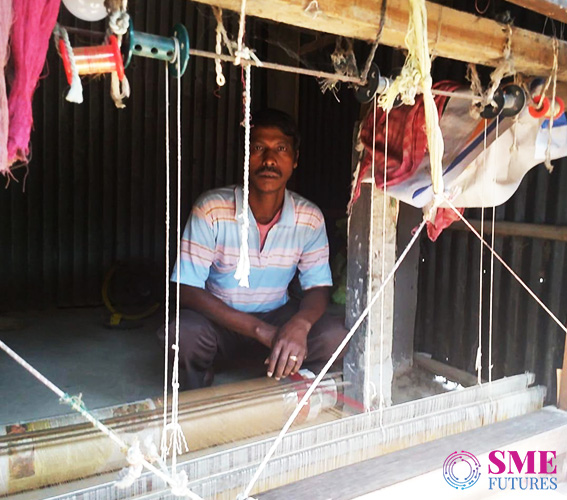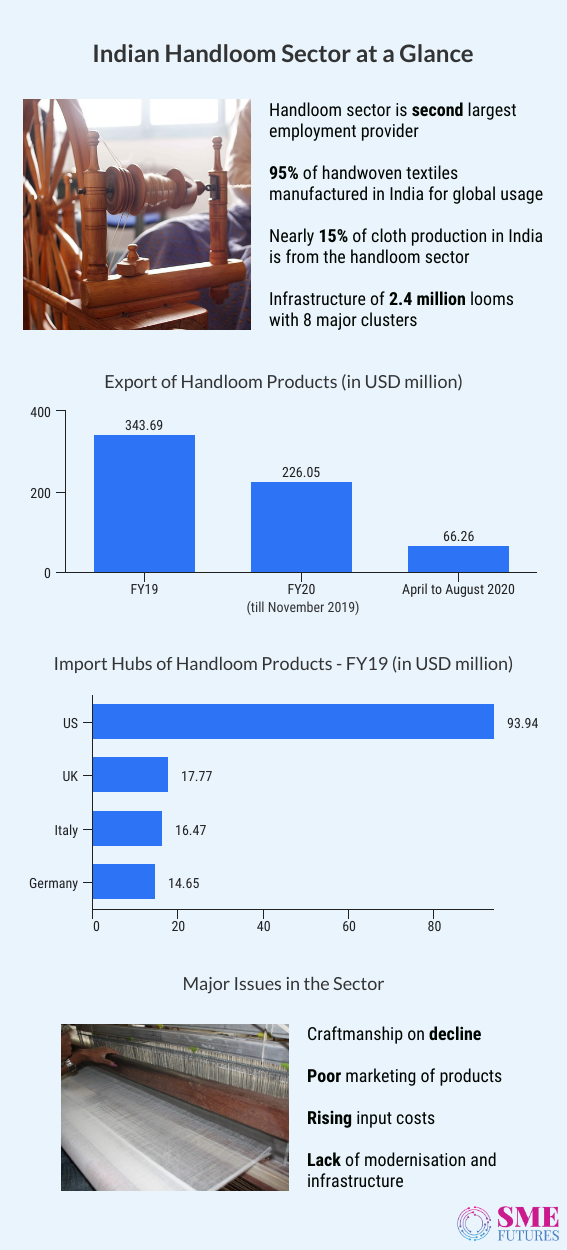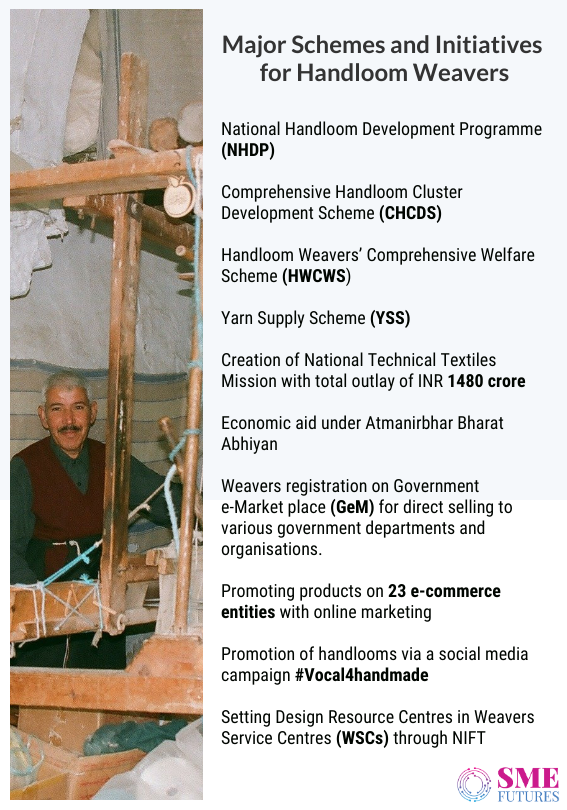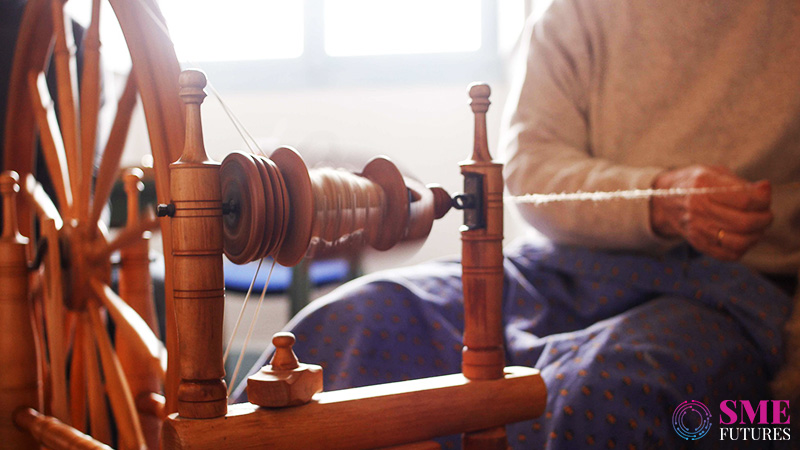Handloom textiles and handicrafts form a special place in India’s cultural heritage, since weaving is the second largest source of livelihood after agriculture in rural India. The ikkat of Odisha, Kalamkari from Andhra, Rajasthani Sheesha work, Telangana’s pochampally, Kashmir’s pashmina, eri silk from north-eastern India, and Lucknow’s Chikan and zardozi work, all are part of India’s glorious treasure trove of fabrics and handloom techniques.
Historians have also described intricate hand works and Indian textiles in their treatises. The uniqueness in weaving styles of each technique and intricate motifs which vary even within communities have evolved along with Indian history. India today manufactures 95 per cent of handwoven textiles for global usage. Furthermore, the handloom industry involves 4.3 million people directly and indirectly in this trade.
According to IBEF, the export of handloom products from India was valued at US$ 343.69 million in FY19. The exports stood at US$ 226.05 million during FY20 (till November 2019). Along with this, there is a conscious growth of fondness and awareness for handloom work so much that the government of India has declared 7 August as National Handloom Day. This is to signify the century-old Swadeshi movement that started in 1905 on the same date.
Despite the economic and social significance of the Indian handloom industry, the situation on the ground is extremely discouraging. No safeguarding of weavers’ interests, a decline in craftsmanship, and receding input costs are some challenges among others that plague the handloom industry. The impact of pandemic has further rubbed salt on the wounds of manufacturers. SME Futures spoke to industry experts to gain an insight into the challenges of this sector and how these can be tackled.

Industry reeling under the pandemic
Till 2017-18, India was the second-largest exporter of handloom products in the world with US$ 353.9 million worth of exports. But COVID-19 dramatically altered this situation. Reasons behind this were piled up inventories, cancellation of orders, and demand-supply constraints due to initial stages of lockdowns. As a result, the handloom products exported between April to August 2020 slid to US$ 66.26 million.
Entrepreneurship Development Institute of India (EDII) which runs initiatives for people in the handloom sector has been observing the scenario. Presenting his opinion on this, Faculty Member and Director at the Department of Projects-Corporate, Dr. Raman Gujral says, “COVID -19 pandemic has badly affected most of the economies across the world. Increased unemployment, business losses, and overall health scare among people have adversely affected consumer behaviour. Hence, handloom products being non-essential have faced the brunt.”
Talking to more people from legacy businesses to start-ups brings further insight. India’s oldest and largest handmade rug maker Obeetee of Mirzapur confesses that the overall handloom industry and its weavers have been deeply affected due to the pandemic. The initial months of lockdowns impacted sales of cotton handlooms during summers. Along with this, the large-scale exhibitions were also cancelled or deferred. This acted as a big blow to industry and impacted the income of those involved in small businesses in this sector.
Angelique Dhama, President-Marketing at Obeetee Pvt Ltd tells, “More and more weavers and craftspeople have left villages for better opportunities in cities. As India came out of several lockdowns lack of sales created a paucity of working capital.” Anirudh Kankatala, Director of Kankatala Sarees, a legacy brand of hand-woven sarees from Vishakapatnam explains, “It is good to see handlooms are back in business. Work is gradually coming on track but there is still uncertainty as corona cases are elevating again.”
Sharing her experience, Anavila Misra, founder of eponymous label Anavila, a niche brand for linen tells, “COVID-19 has impacted various brands and businesses adversely including ours. Sales and production were put on hold for the first few months during the lockdown. During this phase, we shifted our focus to online orders to facilitate sales for our clients. Artisans and weavers who worked from home continued to create new designs for our team.
“We are slowly working towards attaining the same rhythm as in pre-covid times. But consumer behaviour is now shifting and we must keep pace with the changing market dynamics. As the lockdown restrictions have eased, our store is now open to visit on an appointment basis. We are also looking forward positively to the upcoming festive season,” she further adds.
For women entrepreneurs and sister-duo Sujata and Taniya Biswas, Founders of Suta, outbreak of the pandemic proved to be disastrous as the four-year-old hand-woven saree and apparel brand was planning an expansion. Sujata confesses, “Recent developments have left scores of Indian start-ups like us gasping for air. Fashion along with a few other industries has hit an all-time low as the need to wear something fashionable isn’t a priority for people right now. People are saving money as there is job uncertainty and the air of happy shopping isn’t there.”

Factors behind decline of craftsmanship
It is not hyperbolic to say that the Indian handloom clusters are constantly shrinking. As compared to the fourth All India Handloom Census (2019-20) and the earlier census of 1995-96, a vast gap in the number of workers can be seen. There are more than 3.5 million workers (which comprises of 26,73,891 handloom weavers and 8,48,621 allied workers) in the country currently. This is exponentially less as compared to 6.5 million from the 1995-96 census.
Handloom businesses that are mostly dependent on weavers are witnessing a severe manpower crisis. It is because factories were shut and there was no work for at least two months. Hence, weavers moved to their hometowns for other jobs. Power looms also proved to be a threat to craftmanship. Earlier, it took months for weaving and now machines can spin yarns in hours. This has become a challenge for the weavers’ community, costing their jobs.
Low wages or unfair prices for skills have further discouraged people from taking weaving as an occupation. Dr. Gujral says the handloom sector has a rich repository of traditional skills that are passed over through generations. However, due to declining wage-earning potential of the sector, many next generation weavers prefer alternate employment leading to further decline in the craftmanship.
Agreeing with this, Anirudh of Kankatala says, “Children of weavers are not following their parents because of more money in other fields. Hence, fair prices for weavers is the most important step to revive the sector in India and to encourage the next generation to continue weaving.” Dhama also suggests, “To reduce the decline of skills and craftsmanship, we must continue giving work to weavers. This is how we will put back the money where it is needed the most.”
Unorganised businesses and lack of financial aid
Though the sector is distributed into eight mega-clusters, micro-businesses in this industry are still are highly unorganised and run by households. This can be attributed to older looms, inaccessibility to reach markets, and lack of credit. “Handloom industry is dependent on artisans and therefore this sector is driven by unorganised workforce. Handloom brands like us have ensured a basic structure that increases the accessibility of prepared goods among end-users,” opines Anirudh.
Adding to it, weavers lack information and awareness about their target group and associations. According to the latest Handloom Census, only 3 per cent of weavers are aware of the Weavers Health Insurance Scheme and only 10.5 per cent know about credit waivers for loans which they can avail. Due to poor managerial resources and unorganized production, market visibility is becoming difficult for them further.
Dr. Gujral of EDII also points out the problem of profit-sharing. He says, “Collaborations with government departments, local designers, and e-commerce marketplaces can play an important role in enhancing the visibility of handloom products and create market linkages. However, weavers are not able to explore these opportunities due to confined exposure. Hence, they are completely dependent on small traders and master weavers to sell their products. These middlemen take away their large share of profit margin.”
Dhama further emphasises the need for more collaboration. She claims, “The challenge of every business is to keep reinventing for creation of more demand.” It can only be achieved if a firm or master weaver continues to partner under various initiatives. Talking about measures of her firm in this direction, she says, “Our collaborations with designers from across the world not only help us in enriching our design vocabulary but also allows the brand to retain its unique yet global appeal.”
There is hence a dire need to create awareness and to develop an economically sustainable ecosystem for weavers in order to help them survive through this gloomy situation. For this, the government has already implemented a Comprehensive Handloom Cluster Development Scheme (CHCDS) for developing block level clusters across the country. This will cover at least 15,000 handlooms with the government contributing up to Rs 40 crore per cluster for five years.
Various NGOs and organisations such as EDII have also intervened to organise the sector. EDII’s project Handmade in India (HMI) is flourishing in six clusters namely Surendranagar, Bhuj, Maheshwar, Kamrup, Salem and Bargarh. It is enhancing the livelihood capacity of weavers in these districts. Under this project, weavers can reach the market and develop credit linkages. The project also provides soft skills training to weavers and teaches them to use digital payment methods, e-commerce, and social media platforms for promoting their products.

Poor infrastructure adding to woes
Traditional handloom products are one of the major export items from India. Hence, the sector has a magnitude and potential to create unprecedented opportunities for people and businesses. Dhama of Obeetee believes that to harness the actual potential of this industry, the right infrastructure and demand should be developed. She says, “Our rugs are made with immense skills and craftsmanship. The goal is to create a global made in India brand and to revitalise exports to compete effectively against other countries.”
Gujral suggests that this can only be achieved by modernizing the sector. He claims, “Modernizing the handloom sector will go a long way in enhancing weavers’ productivity. Loom upgrade is the need for the hour to achieve zero defect weaving and to produce good quality products that can help weavers in fetching higher prices in the market. Weavers should be facilitated with the use of jacquard system coupled with financial support from government.”
According to Anavila, there are numerous issues, and the government should take care of fundamentals first. For instance, weavers from northeast create beautiful designs and their work is exceptional but there are issues like availability of raw material and connectivity. She adds, “I believe designers and organisations should visit these sectors and collaborate for work opportunities as we have seen in regions of Phulia and Bhuj. The artisans need to work in collaboration with artists.”
Apart from these bottlenecks, access to affordable and good quality yarn is also a big challenge faced by weavers. Despite sufficient yarn depots in most of the clusters, the weavers face difficulties of getting the required material at reasonable prices. Gujral elaborates, “The issue is worse for individual weavers who need a small quantity of yarn. The rising input costs eventually affect the quality of output in the handloom sector. Ever-increasing prices of the yarn make the finished products more expensive which makes getting a higher price more difficult.”
Another prominent reason for the increased input costs is the sector’s shift towards sustainable options. Explaining this, Dhama says, “The costs of raw materials have increased as our brand moves towards sustainable alternatives. We use responsibly sourced wool (RWS) which is more expensive than normal New Zealand wool. Some of our units operate with fair-trade where we give back 1 per cent of the total profit for holistic development of the weaving community.”
Handloom brands steering Atmnirbhar Bharat trend
The handlooms and weavers were already going through a rough patch due to various challenges when the pandemic hit the industries. But small businesses were hit more as it changed consumer sentiment across the entire sector. Now businesses are being conducted through online portals and modern tools. This has further helped artisans, weavers, and businesses in such dire times.
Kankatala’s Anirudh professes that being online for the past three years has put them in a better situation. He says, “During the pandemic, we have made it convenient for our customers to shop online. Our staff conducted video calls from our stores and facilitated doorstep deliveries to our customers. We sold a minimum of 25 sarees per day and a total of 2,600 sarees have been sold since the lockdown. Hence, a 95 per cent rise in online sales was witnessed.”

Similarly, for Suta, which deals with more than 1500 artisans (60 per cent women) for handloom products, things have improved in the past 3 to 4 months. “We won’t say it has come back to normal but we are striving to achieve it,” tells Sujata. The handloom brand has changed its strategy by focussing on repairs, maintenance, and innovations. She further adds, “Our operations and customer support team are focusing on improving minute aspects of shopping on our website. We want our customers to get more enriched shopping experience there.”
Meanwhile, the sounds of handlooms working in units can be heard once again now. The industry also believes that government’s initiatives such as Vocal for Local and Aatmanirbhar Bharat are expected to bring back the lost sheen of the handloom industry in India. In addition to this, businesses are also steering the narratives of such programmes to create a healthy ecosystem for both weavers and buyers.
Obeetee is supporting women weavers through a programme incepted in 2015. The initiative provides vocational training for women in rural Uttar Pradesh. So far, 865 women have become professional weavers from their training of 1200 individuals. Along with this, the firm’s Proud to be Indian campaign is helping weavers to collaborate with renowned fashion and textile experts for designing collection with inspiration from rich craft repertoire of their community.
Dhama claims, “We want our weavers to enjoy making a carpet. We believe that art, technology, and social accountability can fix all the problems that exist in villages of India. Obeetee is always available for the service of our family of weavers. Our community is our backbone with whom we have built the organisation in the past 100 years. It is our vision to improve the quality of life and achieve inclusive growth for everyone.”
Suta and Anavila both procure products from local artisans which encourages handwoven goods. Misra of Anavila tells us that craft clusters and textile belts of India offer us a huge opportunity to create products that can lead to a self-dependent India and we are looking at various such opportunities as a brand. “We work with around 160 weavers from different clusters and almost 90 per cent of our work is dependent on them and local craftsmen. Therefore, we work for creating sustainable employment on a long-term basis,” she says.
The sister duo of Suta also works for the welfare of weavers and their families. The startup has been upskilling weavers through various training sessions and virtual meetings. They also look after the education of children of weavers which is provided in local schools. Sujata explains, “We organise events where a major part of profit goes to weavers. Apart from commerce, we educate people about the industry, work, and values we strongly believe in.”
Anirudh of Kankatala Sarees believes that industry has witnessed a lot of changes with upcoming reforms. According to him, businesses have improved their social responsibility quotient and are now paying more attention to the needs of their employees. He feels, “Artisans are paid fairly which ensures that they are retained in the industry which in turn keeps the age-old tradition alive. I believe more brands are doing the same. This is also creating awareness about Indian handloom sector and its increasing significance in Indian economy.”











